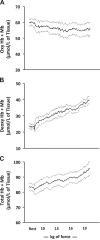Determinants of skeletal muscle oxygen consumption assessed by near-infrared diffuse correlation spectroscopy during incremental handgrip exercise
- PMID: 31318612
- PMCID: PMC6766713
- DOI: 10.1152/japplphysiol.00273.2019
Determinants of skeletal muscle oxygen consumption assessed by near-infrared diffuse correlation spectroscopy during incremental handgrip exercise
Abstract
Near-infrared diffuse correlation spectroscopy (DCS) is a rapidly evolving optical imaging technique for the assessment of skeletal muscle O2 utilization (mVO2). We compared DCS-derived determinants of mVO2 with conventional measures [blood flow by brachial artery Doppler ultrasound and venous O2 saturation ()] in eight volunteers at rest and during incremental handgrip exercise. Brachial artery blood flow and DCS-derived blood flow index (BFI) were linearly related (R2 = 0.57) and increased with each workload, whereas decreased from 65.3 ± 2.5% (rest) to 39.9 ± 3.0% (light exercise; P < 0.01) with no change thereafter. In contrast, DCS-derived tissue O2 saturation decreased progressively with each incremental stage (P < 0.01), driven almost entirely by an initial steep rise in deoxyhemoglobin/myoglobin, followed by a linear increase thereafter. Whereas seemingly disparate at first glance, we believe these two approaches provide similar information. Indeed, by plotting the mean convective O2 delivery and diffusive O2 conductance, we show that the initial increase in mVO2 during the transition from rest to exercise was achieved by a greater increase in diffusive O2 conductance versus convective O2 delivery (10-fold vs. 4-fold increase, respectively), explaining the initial decline in . In contrast, the increase in mVO2 from light to heavy exercise was achieved by equal increases (1.8-fold) in convective O2 delivery and diffusive O2 conductance, explaining the plateau in . That DCS-derived BFI and deoxyhemoglobin/myoglobin (surrogate measure of O2 extraction) share the same general biphasic pattern suggests that both DCS and conventional approaches provide complementary information regarding the determinants of mVO2.NEW & NOTEWORTHY Near-infrared diffuse correlation spectroscopy (DCS) is an emerging optical imaging technique for quantifying skeletal muscle O2 delivery and utilization at the microvascular level. Here, we show that DCS provides complementary insight into the determinants of muscle O2 consumption across a wide range of exercise intensities, further establishing the utility of DCS.
Keywords: Fick principle; blood flow; near-infrared spectroscopy; oxygen uptake.
Conflict of interest statement
No conflicts of interest, financial or otherwise, are declared by the authors.
Figures




Similar articles
-
Near-infrared diffuse correlation spectroscopy tracks changes in oxygen delivery and utilization during exercise with and without isolated arterial compression.Am J Physiol Regul Integr Comp Physiol. 2020 Jan 1;318(1):R81-R88. doi: 10.1152/ajpregu.00212.2019. Epub 2019 Nov 20. Am J Physiol Regul Integr Comp Physiol. 2020. PMID: 31746636 Free PMC article. Clinical Trial.
-
Studies into the determinants of skeletal muscle oxygen consumption: novel insight from near-infrared diffuse correlation spectroscopy.J Physiol. 2019 Jun;597(11):2887-2901. doi: 10.1113/JP277580. Epub 2019 Apr 29. J Physiol. 2019. PMID: 30982990 Free PMC article.
-
Reliability of muscle blood flow and oxygen consumption response from exercise using near-infrared spectroscopy.Exp Physiol. 2018 Jan 1;103(1):90-100. doi: 10.1113/EP086537. Epub 2017 Nov 22. Exp Physiol. 2018. PMID: 29034529
-
Effects of ageing on muscle O2 utilization and muscle oxygenation during the transition to moderate-intensity exercise.Appl Physiol Nutr Metab. 2007 Dec;32(6):1251-62. doi: 10.1139/H07-121. Appl Physiol Nutr Metab. 2007. PMID: 18059603 Review.
-
Principles, techniques, and limitations of near infrared spectroscopy.Can J Appl Physiol. 2004 Aug;29(4):463-87. doi: 10.1139/h04-031. Can J Appl Physiol. 2004. PMID: 15328595 Review.
Cited by
-
Variability in the Aerobic Fitness-Related Dependence on Respiratory Processes During Muscle Work Is Associated With the ACE-I/D Genotype.Front Sports Act Living. 2022 May 19;4:814974. doi: 10.3389/fspor.2022.814974. eCollection 2022. Front Sports Act Living. 2022. PMID: 35663500 Free PMC article.
-
Measurement of muscle blood flow and O2 uptake via near-infrared spectroscopy using a novel occlusion protocol.Sci Rep. 2021 Jan 13;11(1):918. doi: 10.1038/s41598-020-79741-w. Sci Rep. 2021. PMID: 33441688 Free PMC article.
-
Near-infrared diffuse correlation spectroscopy tracks changes in oxygen delivery and utilization during exercise with and without isolated arterial compression.Am J Physiol Regul Integr Comp Physiol. 2020 Jan 1;318(1):R81-R88. doi: 10.1152/ajpregu.00212.2019. Epub 2019 Nov 20. Am J Physiol Regul Integr Comp Physiol. 2020. PMID: 31746636 Free PMC article. Clinical Trial.
-
Non-invasive monitoring of microcirculation dynamics in hypovolemic shock: a novel application of diffuse correlation spectroscopy.Intensive Care Med Exp. 2025 Jun 1;13(1):53. doi: 10.1186/s40635-025-00761-9. Intensive Care Med Exp. 2025. PMID: 40450616 Free PMC article.
-
Vascular ATP-sensitive K+ channels support maximal aerobic capacity and critical speed via convective and diffusive O2 transport.J Physiol. 2020 Nov;598(21):4843-4858. doi: 10.1113/JP280232. Epub 2020 Sep 1. J Physiol. 2020. PMID: 32798233 Free PMC article.
References
-
- Baker WB, Li Z, Schenkel SS, Chandra M, Busch DR, Englund EK, Schmitz KH, Yodh AG, Floyd TF, Mohler ER III. Effects of exercise training on calf muscle oxygen extraction and blood flow in patients with peripheral artery disease. J Appl Physiol (1985) 123: 1599–1609, 2017. doi:10.1152/japplphysiol.00585.2017. - DOI - PMC - PubMed
-
- Bentley RF, Kellawan JM, Moynes JS, Poitras VJ, Walsh JJ, Tschakovsky ME. Individual susceptibility to hypoperfusion and reductions in exercise performance when perfusion pressure is reduced: evidence for vasodilator phenotypes. J Appl Physiol (1985) 117: 392–405, 2014. doi:10.1152/japplphysiol.01155.2013. - DOI - PMC - PubMed
Publication types
MeSH terms
Grants and funding
LinkOut - more resources
Full Text Sources
Medical

